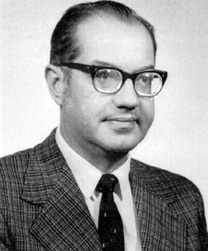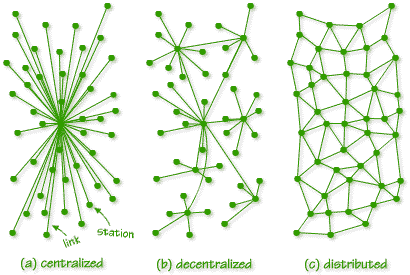Paul Baran's
invention of the distributed network and packet-switching
Dirk Husmeier
February
2001
- The
challenging task for the Arpanet
- Paul
Baran
- Distributed
versus centralised network
- Packet
switching versus circuit switching
- Digital
versus analogue signals
- The
reaction of AT&T
By the time the Arpanet started off as an experimental project to establish a
geographically distributed network of computers - first suggested by J.C.R. Licklider, and
from 1966 on headed by Larry Roberts - the
challenging technical problem of how to link computers together in a digital
communications network had already been solved. It is just that this was unknown
to Roberts - and had nearly been lost to history altogether.
 Baran
was born in Poland in 1926, and his family emigrated to the United States two
years later. After graduating in electrical engineering from Drexel University
in 1949, Baran took a job as a technician at Eckert-Mauchly Computer
Corporation. In 1959 he earned a master's degree from UCLA, and went to the
computer science department of the RAND
Corporation, a nonprofit research and development organisation funded mostly
by US government grants. At that time the RAND Corporation focused mostly on
Cold War-related military problems, and Baran developed an interest in the
survivability of communications systems under nuclear attack. By late 1960 Baran
had come up with three revolutionary ideas. (Further details and image
reference)
Baran
was born in Poland in 1926, and his family emigrated to the United States two
years later. After graduating in electrical engineering from Drexel University
in 1949, Baran took a job as a technician at Eckert-Mauchly Computer
Corporation. In 1959 he earned a master's degree from UCLA, and went to the
computer science department of the RAND
Corporation, a nonprofit research and development organisation funded mostly
by US government grants. At that time the RAND Corporation focused mostly on
Cold War-related military problems, and Baran developed an interest in the
survivability of communications systems under nuclear attack. By late 1960 Baran
had come up with three revolutionary ideas. (Further details and image
reference)
Baran's first idea was that of a distributed network.

In a centralised network (left), each node is connected to each other
node via a centralised hub. All data are sent from an individual node to the
centre and then routed to its destination. This is the most parsimonious
structure in that there is one and only one route connecting any two nodes. The drawback is a maximum degree of vulnerability: If
the central node is destroyed or not functional, all communication is
effectively cut off. This shortcoming is partly redeemed in a
decentralised network (middle), where several centralised hubs are
employed. The destruction of one of the central hubs does not cut off the
communication of the network as a whole. It does, however, affect all the nodes
linked to the destructed of disfunctional hub. Also, if a link between a node
and its centre is destroyed or not functioning, this node is effectively cut
off. A solution to this problem is shown on the right. This so-called
distributed network has no centralised hubs. Each node is connected to
several of its neighbouring nodes in a lattice-like configuration. The
robustness results from the high degree of redundancy that is inherent in this
structure: Each node has several possible routes to send data. If one node or
neighbouring route is destroyed, another path is available.
The problem in realising this idea was that the existing telephone network
worked with analogue signals. At each node the signal would be slightly
distorted and the signal quality would degrade rapidly with the increased number
of nodes between the sender and the receiver. This is similar to what happens
when making copies of copies of audio tapes, where for each new generation the
quality deteriorates.
The solution to this problem was to convert the analogue signals into digital
ones, that is, into streams of ones and zeroes. Besides allowing the application
of efficient compression algorithms, so that less data have to be transmitted to
convey the desired information, digital signals are more robust with respect to
noise and transmission errors. Analogue signals are drastically attenuated by
distance and are easily corrupted by interference and switching. In digital
signals, on the other hand, transition errors can easily be detected and
corrected. There are various error-correction methods available. In the simplest
case, the transmitter adds a parity bit at the end of each group of digits,
which indicates whether the group has an even or an odd number of ones in it. On
receiving the group, the receiver checks to see whether the sequence of bits has
the right number of ones. If not, it requests retransmission of the group.
The switching from analogue to digital signals, however, highlighted another
shortcoming of the existing communications network, and questioned the very
principle on which it was based: the method of circuit switching.
In a circuit-switched network architecture, a dedicated circuit is
established between a sender and a receiver, and the signals coming from one end
are transmitted to the other. This connection is maintained for as long as both
parties desire, after which it is closed. The drawback is that if a large part
of a conversation consists of silence, the line carrying the conversation is
effectively idle for most of the time. This problem is considerably aggravated
for digital signals, which are sent in staccato bursts rather than
continuously. Since no other use can be made of a line while a call is in
progress, circuit-switching inevitably suffers from a considerable waste of
expensive resources.
This problem can be solved by packet-switching. The idea is to divide
messages into message blocks or packets before sending them out across
the network. The blocks are sent separately and rejoined into a whole when they
are received at their destination. To this end, packets are put in the computer
equivalent of an envelope, which contains information on the origin, the address
and the sequence number. In the place of switches which merely connect and
disconnect circuits, packet networks use routers - computers that read the
address of a packet and pass it to another router closer to the destination. At
the destination, the packets are received, reassembled in the correct order, and
converted back into the original message. The routers are permanently connected
via high-speed lines, whose capacity is used much more economically than the
links of a circuit-switched network. Click here for
further details.
The American telephone company AT&T rejected Baran's ideas and used its
monopoly to stifle the innovation. AT&T's officials refused to acknowledge
the presumptive failure of the existing communications network in the Doomsday
scenario of a nuclear attack. It was only five years later, when ARPA started
with its experimental project to link computers together, that the existing
network paradigm of AT&T failed unequivocally. By this time packet switching
had been independently reinvented by Donald
Davies.
Back to the main
page.  Baran
was born in Poland in 1926, and his family emigrated to the United States two
years later. After graduating in electrical engineering from Drexel University
in 1949, Baran took a job as a technician at Eckert-Mauchly Computer
Corporation. In 1959 he earned a master's degree from UCLA, and went to the
computer science department of the RAND
Corporation, a nonprofit research and development organisation funded mostly
by US government grants. At that time the RAND Corporation focused mostly on
Cold War-related military problems, and Baran developed an interest in the
survivability of communications systems under nuclear attack. By late 1960 Baran
had come up with three revolutionary ideas. (Further details and image
reference)
Baran
was born in Poland in 1926, and his family emigrated to the United States two
years later. After graduating in electrical engineering from Drexel University
in 1949, Baran took a job as a technician at Eckert-Mauchly Computer
Corporation. In 1959 he earned a master's degree from UCLA, and went to the
computer science department of the RAND
Corporation, a nonprofit research and development organisation funded mostly
by US government grants. At that time the RAND Corporation focused mostly on
Cold War-related military problems, and Baran developed an interest in the
survivability of communications systems under nuclear attack. By late 1960 Baran
had come up with three revolutionary ideas. (Further details and image
reference)
